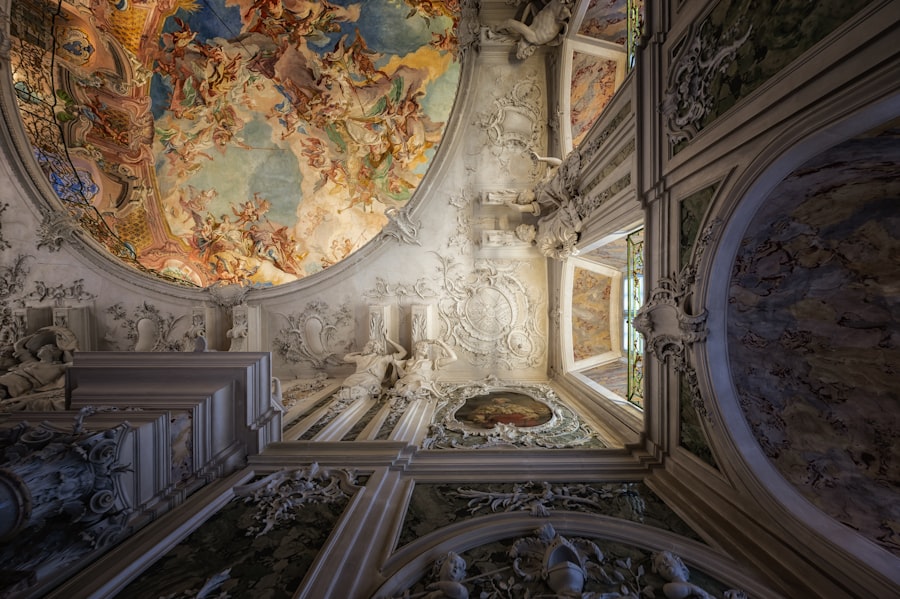Restoration of Manila Cathedral: A Symbol of Resilience
Description
The Manila Cathedral, officially known as the Cathedral-Basilica of the Immaculate Conception, has a rich and storied history that dates back to the Spanish colonial period. The original structure was built in 1581, making it one of the oldest churches in the Philippines. It was initially constructed as a simple wooden structure to serve as the seat of the Archdiocese of Manila.
Over the years, the cathedral underwent several reconstructions due to various calamities, including fires and earthquakes that plagued the region. The first stone structure was completed in 1592, but it was not until 1626 that it was consecrated as a cathedral. Throughout its history, the Manila Cathedral has been a witness to significant events in Philippine history.
It has hosted numerous important ceremonies, including the weddings of prominent figures and the funerals of national heroes. The cathedral has also served as a refuge during times of conflict, providing sanctuary to those seeking safety during the tumultuous periods of colonial rule and World War
Key Takeaways
- Manila Cathedral has a rich history dating back to the Spanish colonial period, with several reconstructions due to natural disasters and war.
- Destruction and restoration efforts have been ongoing, with the latest restoration project completed in 2014 after damage from natural disasters and World War II.
- The cathedral holds deep symbolism for the Filipino people, representing their faith and resilience in the face of adversity.
- Architectural features and design elements of the cathedral showcase a blend of different styles, reflecting the country’s diverse cultural influences.
- The Manila Cathedral plays a significant role in Philippine culture and society, serving as a place of worship, historical landmark, and venue for important events.
Destruction and Restoration Efforts
The Manila Cathedral has faced numerous challenges throughout its existence, particularly in terms of destruction and subsequent restoration efforts. The most devastating event occurred during World War II when the cathedral was heavily bombed by Japanese forces in 1945. The once-majestic structure was reduced to ruins, leaving only fragments of its former glory.
In the years following the war, various restoration efforts were initiated to rebuild the cathedral. The first major restoration took place in 1954 under the guidance of architect Fernando Ocampo, who aimed to recreate the cathedral’s original design while incorporating modern materials and techniques.
However, this restoration was not without its challenges, as funding and resources were limited in the post-war era. Subsequent restorations occurred in 1976 and 1981, each time striving to preserve the historical integrity of the structure while adapting to contemporary needs.
Symbolism of Manila Cathedral

The Manila Cathedral stands as a powerful symbol of faith and resilience for Filipinos. It represents not only the religious devotion of the Catholic community but also serves as a national emblem of unity and hope. The cathedral’s significance extends beyond its religious functions; it embodies the struggles and triumphs of the Filipino people throughout history.
Its enduring presence amidst adversity reflects the strength of faith that has sustained generations. Moreover, the cathedral is often seen as a beacon of hope during times of crisis. It has been a site for prayer and reflection during national tragedies, such as natural disasters and political upheavals.
The annual celebrations held at the cathedral, including Christmas Masses and Easter Vigil services, draw thousands of worshippers who come together to celebrate their shared beliefs and cultural heritage. This communal aspect reinforces the cathedral’s role as a unifying force within Philippine society.
Architectural Features and Design
| Feature | Description | Metrics |
|---|---|---|
| Windows | Provides natural light and ventilation | Number of windows, size, orientation |
| Roof Design | Protects from weather and adds aesthetic value | Material, slope, area |
| Facade | Exterior appearance of the building | Material, color, texture |
| Architectural Style | Overall design and aesthetic of the building | Modern, traditional, contemporary |
The architectural design of Manila Cathedral is a remarkable blend of Romanesque and Neo-Gothic styles, showcasing intricate details that reflect both its historical significance and artistic merit. The current structure, completed in 1958, features a grand façade adorned with impressive sculptures and reliefs that depict biblical scenes and figures. The use of local materials, such as bricks and stones, adds to its unique character while paying homage to Filipino craftsmanship.
One of the most striking features of the cathedral is its magnificent bell tower, which stands at an impressive height and serves as a prominent landmark in Manila. The tower houses several bells, each with its own distinct history and significance. The interior of the cathedral is equally captivating, with soaring ceilings supported by elegant arches that create an atmosphere of reverence and awe.
Stained glass windows depicting various saints and biblical narratives filter sunlight into vibrant colors, enhancing the spiritual ambiance within.
Role in Philippine Culture and Society
The Manila Cathedral plays a pivotal role in shaping Philippine culture and society. As one of the most important religious institutions in the country, it serves as a center for Catholic worship and community gatherings. The cathedral hosts various liturgical events throughout the year, including weddings, baptisms, and confirmations, marking significant milestones in the lives of countless Filipinos.
These ceremonies are often steeped in tradition, reflecting the deep-rooted cultural practices that have been passed down through generations. Beyond its religious functions, the cathedral also serves as a cultural hub that fosters artistic expression and community engagement. Concerts, art exhibits, and cultural festivals are often held within its vicinity, attracting both locals and tourists alike.
This vibrant cultural scene contributes to a sense of belonging among community members while promoting appreciation for Filipino heritage. The cathedral’s role extends into social issues as well; it often serves as a platform for advocacy on matters such as social justice, environmental stewardship, and human rights.
Importance of the Restoration Project

The restoration project of Manila Cathedral is not merely an architectural endeavor; it represents a commitment to preserving cultural heritage for future generations. Recognizing the significance of this historical landmark, various stakeholders—including government agencies, religious organizations, and private donors—have come together to support restoration efforts. This collaborative approach underscores the collective responsibility to safeguard national treasures that embody shared values and identity.
The restoration project also aims to enhance accessibility for visitors while ensuring that the cathedral remains functional for worshippers. Modern amenities are integrated into the design without compromising historical integrity, allowing for a seamless blend of old and new. By investing in restoration efforts, stakeholders are not only preserving a physical structure but also revitalizing community pride and fostering a deeper connection to Philippine history.
Challenges and Triumphs in the Restoration Process
The journey of restoring Manila Cathedral has been fraught with challenges that test both resolve and creativity. One significant hurdle has been securing adequate funding for restoration projects amidst competing priorities within government budgets and economic constraints. Additionally, navigating bureaucratic processes can delay progress, requiring persistent advocacy from supporters who recognize the cathedral’s importance.
Despite these challenges, triumphs have emerged throughout the restoration process. Innovative fundraising campaigns have garnered support from both local and international communities who recognize the value of preserving cultural heritage. Furthermore, collaboration with skilled artisans and craftsmen has ensured that traditional techniques are employed in restoration efforts, maintaining authenticity while showcasing Filipino talent.
Each successful phase of restoration serves as a testament to resilience and dedication toward preserving this iconic landmark.
Future Plans and Impact on the Community
Looking ahead, future plans for Manila Cathedral include ongoing maintenance initiatives aimed at ensuring its longevity while enhancing visitor experience. Educational programs are being developed to engage younger generations with the cathedral’s history and significance, fostering a sense of stewardship among future custodians of this cultural treasure. Additionally, plans for improved infrastructure around the cathedral aim to create a more welcoming environment for both worshippers and tourists.
The impact on the community is expected to be profound as these initiatives unfold. By strengthening ties between faith, culture, and education, Manila Cathedral can continue to serve as a focal point for community engagement and social cohesion. As it stands resilient against time’s challenges, it will undoubtedly remain a source of inspiration for generations to come—an enduring symbol of faith, hope, and unity within Philippine society.
If you are interested in learning more about historical landmarks in the Philippines, you may want to check out this article about the Manila Cathedral here. The Manila Cathedral is a significant cultural and religious site in the country, and this article provides valuable insights into its history and significance.
FAQs
What is the Manila Cathedral?
The Manila Cathedral, also known as the Metropolitan Cathedral of the Immaculate Conception, is a Roman Catholic basilica located in the Intramuros district of Manila, Philippines.
When was the Manila Cathedral built?
The original Manila Cathedral was built in 1581, but it has been destroyed and rebuilt several times due to natural disasters and wars. The current structure was completed in 1958.
What is the architectural style of the Manila Cathedral?
The Manila Cathedral features a combination of architectural styles, including Baroque, Neo-Romanesque, and Neo-Byzantine influences.
What is the significance of the Manila Cathedral?
The Manila Cathedral is a significant religious and cultural landmark in the Philippines. It has been the site of many important events in the country’s history, including the papal visits of Pope Paul VI and Pope John Paul II.
Is the Manila Cathedral open to the public?
Yes, the Manila Cathedral is open to the public for worship, prayer, and tourism. Visitors are welcome to explore the cathedral’s interior and attend Mass.
Is there an entrance fee to visit the Manila Cathedral?
There is no entrance fee to visit the Manila Cathedral. However, donations are welcome to support the maintenance and preservation of the historic building.





